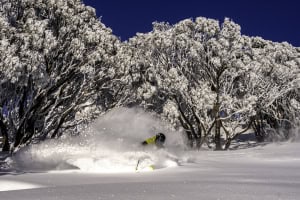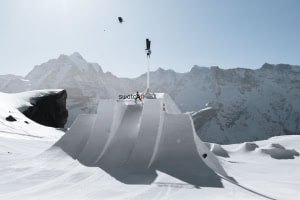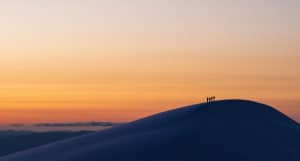TRAVEL – Guns Of Gulmarg

Story by Bex Sandys | Photos by Tyler Heffernan
We had heard amazing stories of this place: 18 metre snow bases, one metre overnight snow dumps and heli-like experiences right from the top of a gondola that drops you high in the Himalayas. Understandably our expectations for Gulmarg, India were high.
Nothing prepares us for the blaring horns and chaotic roads of Delhi, our Indian entry point en route to the Kashmir ski resort village of Gulmarg. There’s no sense of road rules or give way action, two lanes of traffic can quickly become four, horns become indicators and cars play bumper-car with one another to get through the jams.
So the reality of Srinagar, one and a half hours by plane north west, is sobering. Military guards strapped with AK47’s and ammo belts litter the landscape, some with full face balaclavas, manning mobile machine guns on the back of trucks. The air is tense and so are we.

The drive from there to Gulmarg is another one and a half hours and the landscape quickly changes from the sombre concrete of Srinagar to dirt packed countryside with larger dwellings and rice fields. What was rain soon turns to snow and the atmosphere changes with it; a calming beauty blankets the landscape as the mountains begin to appear.
When we arrive in Tangmarg (the village before Gulmarg) it’s dumping hard. An avalanche in Gulmarg earlier in the day has killed 16 soldiers and the road conditions sound sketchy at best, forcing us into an unscheduled stop for the night. We happily chill and wait for the road to clear.
Five a.m. and Muslim call to prayer echoes throughout the Tangmarg Valley from the mosque across the road, waking us immediately. We’re in Kashmir now, where Islam is the major religion (compared to a Hindu majority in India) and prayers are broadcast the requisite five times each day. Outside the snow has stopped. Barbed wire has been strewn across the entry to the Gulmarg road and army trucks, carrying the bodies of those killed in the avalanche, are making their way to their loved ones. It’s a sombre moment.
But we’re soon back on the road to Gulmarg, all constantly amazed that our driver can talk on the phone, keep his hand on the horn, yell at the guy next to him and not drive us into the snow bank. Every corner we approach the horn is blared; we guess it is to warn oncoming cars of our presence, but if they are tooting too, how can they hear our horn?
Despite this, the drive is beautiful. Occasional breaks in the cloud provide teasing glimpses of the surrounding Himalayas, which creates excitement about what is in store for the next week and a half for our crew of six. The whole area has received a massive dumping of snow – which also means we are put out on the road to struggle the rest of the way to the Alpine Resort Hotel on foot.
Like in many third world countries we, as western travellers, are immediately surrounded by locals wanting to carry our luggage for a small fee. Without a thought, the locals throw a heavy bag full of gear up onto one shoulder and a snowboard bag on the other, trudging through the deep snow to the hotel, showing no sign of struggle or complaint. Tipping 100 Rupee for their efforts, you have to wonder if three dollars is really enough.

(From Top Clockwise: Dahl Lake is a must side trip when you visit Gulmarg and Srinigar. The view from the Bottom of the Phase 2 Gondola in Gulmarg. At Dahl Lake, the streets are water and the cars are boats.
Kashmir In Conflict
Ownership of Kashmir has been a source of conflict between the Indian and Pakistani states since 1947 when Pakistan was formed and the King of Kashmir (the Mahiraji) looked to India for protection. Since then two major wars have broken out in the region, the last in 1965, and Kashmir is now half occupied by India and half by Pakistan. No borders are in place but a ‘Line of Control’ has been established by the two occupied territories. Kashmir remains unstable and has become the staging area for a conflict between huge nuclear nations. It also shares a border with Afghanistan which complicates things even more with the ‘War on Terror’ and al-Qaeda – but we won’t go into that.

This ‘Line of Control’ is 20km from the top ridge at Gulmarg resort and there is a nearby military base – where the soldiers who were killed by the avalanche were based – but surprisingly you don’t see as much military as you would expect and the township exudes a naïve quirky English charm. Local workers make do with what they have available, decked in out-of-fashion winter gear: hand me-downs from visitors past, cobbled together just to keep them warm.
Reliant on Srinagar for supplies, Gulmarg has to be prepared for the worst. The week we arrive the military in Srinagar kill a teenage boy, so in retaliation the local Kashmiri community are on a strike that lasts for a week or so. With supplies held up in Srinagar, the problems for Gulmarg are compounded by the big snowstorm that hit the area days before we arrived. With the main power supply affected, the running of the gondola is dependent on its generator, as are the local businesses. There is mostly no hot water throughout the town and we are now really immersed in the realities of a third world nation.
The Alpine Ridge Hotel, where we are staying, has a generator, but this is used sparingly at best. Power would be on for breakfast, turned off during the day and restarted at night in an effort to conserve fuels. The radiator rooms, with their own hot water supply, feel like 5-star accommodation. Once we get familiar with the routine of the power it is a home away from home – You don’t realise how good it is to finally get a hot shower five days into it!

Riding Zones and Guides
The town of Gulmarg is at 2700m above sea level and the top of the gondola drops you at 4150m – the highest gondola in the world. The terrain is huge and all over the show, after all this is the Himalayas – the world’s biggest mountain range.
But when the top gondola isn’t open, like on our first few days, due to heavy snow and the strike, it’s time to get your hike on and Monkey Hill is the place to do it. Sitting in the tree line, Monkey Hill has some awesome terrain. There are all kinds of natural rolls and kickers with sky-reaching trees that part to expose powder pillows and enough room to get some epic riding in.

We learn early on that you have to put in the work to reap snowboarding rewards at Gulmarg. Even with Phase One of the gondola operating, we’re still hiking to find the right spot for kickers and some sweet powder turns. With Phase One taking us up to 3000mtrs, the gondola ride is an experience in itself. You are yelled at to “GET IN”, and are pushed into the small carriage – you have to be fast and not worried about being in close proximity to people. One gondola carriage will carry six tourists in summer comfortably. In winter, adding skis, snowboards and packs it’s a tight squeeze. If you’re sharing it with skiers the doors won’t close all the way, as the carriages aren’t tall enough for the skis to fit in.
The ride to the top of Phase One takes around seven minutes, giving us a good chance to check out the surrounding features. The terrain from here down is in the tree line, and can be quite flat in places, but there’s a good share of nice mellow rolly bits amongst the trees. It’s a sparser forest than Monkey Hill, but it still covers a lot of this area. As you get higher up the mountain the trees start to thin out.
From the top of Phase One gondola station, you can head left or right; we took the left line, hiking the flat for a good 5 mins before taking a soft powder ride to an incline of trees. Dropping into this is magic; the snow isn’t heavy or too tracked out, just good smooth fun snow. It’s perfect for finding sweet spots for building jumps. This is where we build a cheese wedge between two trees and session this for a few hours. It’s awesome at the end of a jump session to make your way down through the trees, mindful to keep clear of the flat spots housing snow-covered horse stables. There is a decent sized cat track carved out to make the ride back to the bottom gondola rideable without having to unstrap to skate or walk it.
The Gulmarg gondola Phase Two opened for a couple of hours one afternoon, and half a day another while we were there, but then we score gold on our last morning. The lift opens first thing and the elusive Phase Two is ready and waiting. The tree line gives way to an expansive bowl. The middle of this has been sessioned pretty hard, but the awesome thing about this place is it is so spacious you can traverse out to the sides for untouched goodness. The freedom of riding your line, floating through this untouched powder, surrounded by the Himalayan backdrop goes beyond words. You feel so connected to the world around you it’s like you’re all one and the same. Being able to say you’ve ridden the highest gondola in the world is pretty sweet. Although the gondola doesn’t go to the peak of the range, you can hike from there along the ridge to access 15 or more other bowls either side but the terrain from the peak isn’t covered in the avalanche control and it isn’t patrolled so you need a guide, gear and experience.
Hiring a local guide is the best investment we make. Our guide, Wali, has been guiding in Gulmarg for 35 years. Skiing there since he was a boy, Wali knows all the sweet spots of Mt Apharwat and the Pir Panjal Range that surrounds Gulmarg. He knows exactly what we are looking for and never fails to deliver us the goods. Having a guide with you makes navigating your way through the tree line and the gondola line so much easier. Busting through to the top of the queue because your guide knows the guys running the gondola will make your day!

On stormy days the best riding can be found in and around Monkey Hill – or simply in and around the village. Quentin Robbins taking advantage of some village pillow drops.

Rob Mitchel made the most of the deep snow in and around Gulmarg while the top of the gondola was closed. Roof gap to step down.

Quentin Robbins throwing a stylish method through the trees of Monkey Hill. Quentin rode a powder specific fish-style snowboard the whole trip, which made light work of the deep pow.
Dangers Other Than Pakistan
Gulmarg isn’t like any resort you’ve ever been too or will ever go to. There are real dangers and you really need to know what’s around you. You need to know your shit regarding snow pack, using your transceiver and keeping safe. Most travel insurance policies won’t cover you for Gulmarg as it is all off-piste terrain; it’s worth paying that bit extra to get off-piste cover. An injury you’d hardly be concerned about at a home resort could end up life threatening in Gulmarg and without insurance treatment may not happen.

With the avalanche danger at considerable, to go out riding without a transceiver, shovel and probe is plain stupid anywhere, but in Gulmarg, where there is no search-and-rescue and no heli for an emergency evacuation, it’s suicide. There is no medical centre or hospital in Gulmarg either, the closest hospital is down in Tangmarg, so it comes down to the people you’re riding with to get you out if you injure yourself.
A couple of years back, a female snowboarder from Europe went riding by herself in whiteout conditions, without a transceiver, and told no one where she was headed. The search for her was concentrated near the gondola, but her body was located in the empty reservoir on Monkey Hill later that spring, her board still attached to her feet. Just this season a Russian skier was lucky to survive his solo skiing mission. He hit a tree, breaking his femur, he had no one with him to go and get help. Luckily an Australian traveller heard his yells later that day and raised the alarm – he would not have survived the freezing night temperatures.

Rob Mitchel pops a slob off a tree stump in the Monkey Hill trees during the extended storm system that dominated the weather while the Transfer crew were in Gulmarg.

Quentin Robbins exploring Gulmarg with a frontside air.
‘Extra Curricular’ Activites
Kashmir is an Islamic state so the matter of alcohol consumption was on our minds. Lucky for us Alpine Ridge Hotel has its own little bar set up and once dinner is served the Alpine Restaurant becomes the party place of Gulmarg for anyone looking for some extra curricular activities. Some Russians were on hand to show us how to make the perfect hash smoking apparatus, fondly named ‘the duck’. Many nights were spent with people from all over the globe bonding over the continuous 420 experience.
Beyond Gulmarg
When we leave Gulmarg we give our unwanted clothing, shoes and shovels to the locals who made the most impact on us. Anyone visiting Gulmarg should take clothing they can part with at the end. Not only does it lighten your load and make room for the beautiful shawls and scarves on offer at local markets, but you’re making a local that little bit warmer.
After nine days of Gulmarg living, we pack up the jeep and head to Dal Lake to stay in one of the famous house boats, a floating town established by the English when a Kashmari law prohibited them from building houses in the area.
Heath purchases a cricket bat for 150 rupees from the boatbound salesmen that accost tourists on the lake. That afternoon we’re on the hunt for a cricket match – New Zealand vs Srinagar. We head to where the boys had seen a game go down the day before, set up our gear and wait for a challenge.

In no time we are playing a real six aside cricket game, umpire and all. These local guys don’t hold back! As the crowd gathers so does our determination to win, although the scores are close, we go down 3 – 0.
Saying goodbye, our crew heads off to our next destinations, heads reeling from our experience. It is true what they say, you can’t change India, but India will change you – it’s a place you won’t forget.

Quentin Robbins
Travel Info:
Visa: Australians need to apply for a visa from the Indian consulate before departing for India. New Zealanders can process a tourist visa upon arriving in India.
Travel insurance: www.ihi.com has the best policy for injury on off-piste with no excess to pay.
Shots: Hepatitis A, Typhoid and Diphtheria.
Money: The ATMs are super unreliable in Kashmir – get your money in Delhi when you arrive in India.
Antibiotics: Take some with you as it’s sometimes hard to find medical attention in the mountains. Tangmarg hospital is a crazy place and hard to find your way around.
Backcountry: Take a transceiver, shovel and probe.
Delhi Belly: Immodium tablets – you’ll need it. Toilet paper ( not all places have it!)
Avalanche Course in Gulmarg:
An avalanche awareness night was held most Tuesday nights. These evenings were put on by Brian-one of two foreign ski patrollers who have recently been hired by the local tourism body to keep tourists safe and informed while out on the slopes. These were super-informative and let us know what the snow pack was like, the forecast for the next few days, the best and safest places to ride and the expected day of the gondola Phase Two to opening.
Useful websites
www.gulmargsafety.com – gives you updated info on the snowpack and avalanche conditions
www.gulmargpowderguides.com – book a qualified local guide for your trip.

Guns Of Gulmarg was originally published in issue #3 of Transfer Snowboard Magazine Issue.






